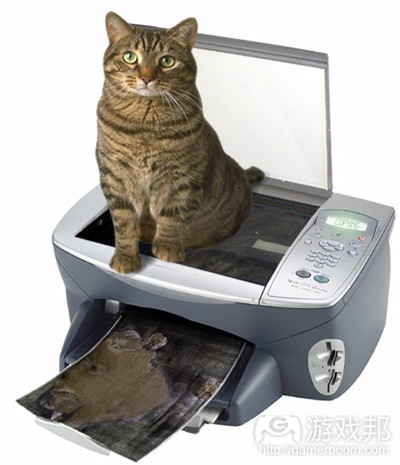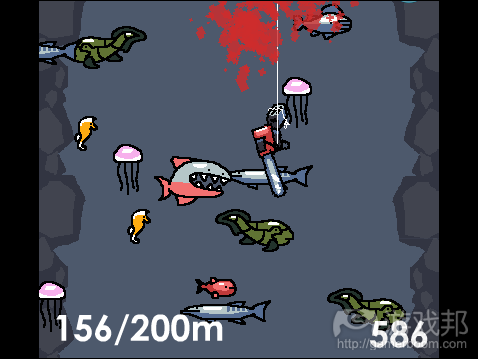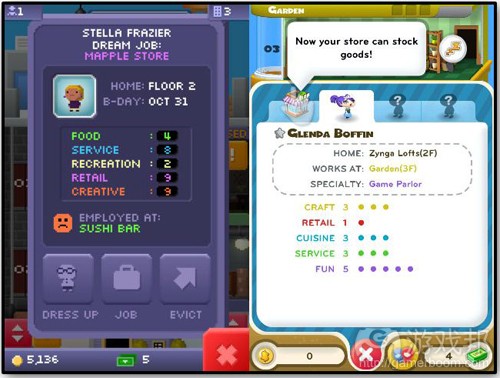App Store是促进还是抑制了游戏设计创新?
作者:Catalin Alexandru
“创新”一词往好处说是陈词滥调,往坏处说就是,它揭露了今天游戏行业所面临的问题。
游戏开发者已经在这一词上频频栽跟头,以至于这个词现在已经失去了原来的意义。
这个行业实际上只有8到9种大家经常重新烹制的游戏设计,就像他们所说的,为何不择其一而行?
既然已经有现成可用的设计模式,为何还要花费如此多成本让大家进行头脑风暴、调研和开发新的玩法机制?
最好是把2D游戏改造成3D版本,或者添加社交机制,异步多人模式。
更可爱的角色,知名授权品牌,更好的产品价值,或者只是略有不同的美术设计也是其他换汤不换药的表现形式,开发者有时候只是对同一款游戏的玩法机制进行包装,再推出一个更为闪亮的版本而已。
更糟糕的是,在快速迭代、用户测试之前,游戏设计创新意味着一个非主流的潮人让项目脱离轨道,停止数年毫无方向的迭代过程。
这是时至今日行业都没有恢复的耻辱。如果设计过程缺乏结构和监督,盲目在设计过程中渗入创新理念很可能给项目带来伤害。
打破旧模式
那么“行业中仅有8种游戏设计模式”的论调究竟是否靠谱?不,事实并非如此。
行业中有上百数,甚至是上千种游戏设计,并且还正在诞生更多种设计,其数量不可估计。
游戏设计创新并不需要在只有时间和预算允许的前提下,项目已经稳定,形成具有可辨识(最重要的是安全性)机制框架的时候才能出场。
也不应该只是光脚不怕穿鞋的独立开发者的专利。
如果系统地推出游戏设计创新,它可以成为推队团队集中点乃至每个关键盈利指标的引擎。
创新可以成为你游戏营销的关键点,打造社区的一个激励因素,并得到掌握行业话语权的人物的支持。
更重要的是,创新才是制作游戏的生存之道,这种时代终会来临。
皇帝的新装
游戏类型不仅仅是定义游戏的过去,还包括它们的未来。
从平台跳跃到街机射击之类的机制优化不是偶然的技术飞跃(游戏邦注:例如从8位至16位,2D到3D),就是附加的元素(例如重力修改器或小工具)。
但几乎每个题材的核心动态,甚至是数十年如一日,鲜有变化。
在家庭主机上发布的游戏间隔时间够长够久,所以其核心机制拥有足够时间进行循环翻新,而不只是利用新外观、技术和功能换了张脸。App Store中涌现的众多换皮游戏表明只有创新才是出路。
苹果平台的崛起并不只是改变了游戏的消费方式,还包括游戏的开发原因和方式。
意外的结果
这并不是说App Store并没有改变游戏开发循环中的许多链条。苹果的软件分布、用户体验和硬件设计都从根本上改变了我们今天的移动领域。
但App Store所带来的最重要影响是萌生创新的设计试验,以及创新的实现方式(更有效而低障碍),它鼓励创新发展。
但这种现象的一个不幸的负面效应就是,它也让山寨比创新更易于实现。
更简便的执行方式并不只是创造了更易于创新的环境,同时也让他人得以用较低的成本山寨现成的游戏。
最近流行的游戏类型——例如自动奔跑以及弹弓物理游戏也开始经历一个相同的循环。
它们因表现出众而崛起,站稳脚跟之后,开始面临大批“模仿者”涌现的生存压力。
改变悬而未决
游戏的真实情况与其包装外观、宣传资料以及技术支持存在出入的观念,最近才开始变成一种普遍现象。
现在有一种观念认为,游戏内部无形的运作方式不但是游戏趣味性的来源,也是令游戏从同一题材众多竞争者中颖而出的重要元素。
在过去一年,行业和玩家如何看待游戏设计创新价值的变化非常迅速。
例如,Vlambeer《Radical Fishing》被克隆风波,就暴露出某些工作室,已成为因创新而得以生存的小型开发商的威胁,并由此引发一场论战。
但最重要的是,这是游戏行业史上首次拷问以新外观包装游戏机制的行为。事实上,有许多人却认为这只是一种比克隆好一点的实践行为。
有些讨论克隆现象的文章晒出了Nimblebit作品《Tiny Tower》和Zynga游戏《Dream Heights》之间的游戏截图进行对比。
它们列出了界面元素,但多数评论却偏离了箭靶。
虽然剽窃游戏的美术风格、菜单设计或界面元素布局确实很可耻,对于被窃者来说,最致命的莫过于游戏的创新机制(而非应用图标设计)被山寨。
诉诸法律
从传统上看,如果游戏拥有原代码、美术、音乐、文案和音效,那么就可以以侵犯版权之名而起诉剽窃者。玩法并不在版权法保护范围之内,因为游戏理念真是难以捉摸,无法让法庭判定的东西。
但2012年在美国却出现了两起判定克隆游戏玩法也是侵权行为的案件。
Spry Fox成功向法官证明公司旗下的《Triple Town》被6Waves的《Yeti Town》所克隆,虽然后者采用了全新的美术设计、主题和代码。最终结果是Spry Fox不得不放弃《Yeti Town》的IP及该游戏所有收益。
克隆《俄罗斯方块》的《Mino》也因法庭判决而被关闭——尽管它除了玩法之外,其他元素均是原创内容。
虽然这并不意味着游戏机制从此就可以被列入版权范围,但至少可以说明现在的游戏机制已经得到更多的法律支持。
去年ngmoco和BenCousins曾尝申报第一人称射击游戏新触碰控制方式的版权。
申报游戏机制和控制方式的版权,以及新的法规出台等一系列现象表明,游戏行业的发展令人担忧。
尽管已经出现了世嘉针对方向箭头的版权,Namco加载页面的迷你游戏等令人警醒的先例,这种借法律途径来减少竞争和独占某一新游戏题材的倾向,还是足以吸引众多游戏公司冒险尝试采用这种扼制创新的手法,以专利侵权之名起诉竞争对手。
一切都是新事物
但事情也有另一面。
这些公司可以通过这场科技领域的专利竞赛汲取经验教训,了解这并非他们想得到的结果。
游戏公司们所担心的并不只是法律干预的问题。
《Fortresscraft》、《Ninja Fishing》以及《Dream Heights》事件均遭遇《Minecraft》、《Radical Fishing》和《Tiny Tower》玩家社区以及媒体的激烈反应,大家都在声援原创作品。
无论是新颖的游戏体验,优秀的数据度量标准,更快乐的团队,还是更低廉的营销成本而推动创新,还是因为对即将出台的法规,激烈市场竞争,粉丝抵制模仿现象的恐惧而被迫创新,只要看到有人打破了“8种游戏设计”的套路,我们都应该报以欣慰的微笑。(本文为游戏邦/gamerboom.com编译,拒绝任何不保留版权的转载请联系:游戏邦)
Best of British: Has the age of the App Store helped or hindered game design innovation?
by Catalin Alexandru
Catalin Alexandru is a game designer and consultant with five years of industry experience who has worked with companies like EA, Mind Candy and Beatnik on franchises ranging from Star Trek to Moshi Monsters.
He’s also the founder of Darkest Timeline Studios, a three-person indie developer.
The word ‘innovation’ is, at best, an utter cliché. At worst, it’s a dirty word the moment it’s mentioned in the context of today’s game industry.
Game makers have been hit over the head with it (or lack thereof) for so long that the word now fails to mean much of anything.
There are only about eight or nine game designs that everyone keeps rehashing anyway – or so they keep telling me – so why not just pick one of those and run with it?
What’s the point in paying people to brainstorm, research and develop new play mechanics when there are old ones right there for the taking?
Far better to start with a 2D game and make it 3D. Or add social mechanics, or asynchronous multiplayer.
Cuter characters, a well known license, better production values or just slightly different artwork are other ways less than original developers sometimes dress up established mechanics to pass off a shinier version of the same game.
To make matters worse, back before rapid prototyping, ubiquitous user testing and cast iron user experience axioms, innovation in game design was the boogey man that drove projects off the rails and kept them off in aimless iteration land for years.
It’s a stigma which to this day it hasn’t recovered from. Indeed, when the design process lacks structure and oversight, tossing innovation into the mix still has the potential to cause damage.
Mythbusting
As for the “there are only eight game designs in all” argument – is there any truth in it? No. No, there isn’t.
There are hundreds – possibly thousands – and more are being created all the time, but nowhere near the number that could be.
Game design innovation needn’t be the stunted, timid thing that’s only ever attempted if time and budget allows, and after the project has stabilised as an established, recognisable (and most importantly safe) mechanical framework.
It needn’t be the sole province of indies with nothing to lose, either.
Far from being a money and focus sink, if approached methodically and respectfully, it can be the engine that drives everything from team focus to every key monetisation metrics.
Innovation can be a key point in your game’s marketing and a galvanising factor in creating a community and garnering support from influential voices in the industry who have made a vocation out of advocating new and original game experiences.
Even more importantly, it’s now possible to imagine that there will come a time when it’s the only way to continue making games at all. At least after a fashion.
The emperor’s new couture
For the longest time, game genres defined not only what games were, but what they could be.
Mechanical improvements to everything from platformers to arcade shooters were either incidental technological leaps, such as from 8 bit to 16 bit, or 2D to 3D, or additive, like gravity modifiers or gadgets.
The core dynamics for almost every genre, however, remained static for years. Sometimes even for decades.
Releases on home consoles were few and far enough apart for the blatant recycling of core mechanics in entire genres to barely register under the sheen of new visuals, technology and features. The App Store’s flood of old games in new clothes is currently straining that strategy to breaking point.
The rise of the Apple’s platform hasn’t just changed the way games are consumed, but rather how and why they’re developed.
Unintended consequences
That’s not to say the App Store hasn’t change a myriad of links in the development chain. Software distribution, user experience and hardware design have all had to fundamentally change in order to get us where we are today.
However, the most important impact the App Store has had is making both the experimentation with design that spawns innovation, and the implementation of it, more cost effective and painless than ever, thus allowing it to flourish.
The unfortunate side effect of that explosion is that it’s always easier to copy than to invent.
Easier implementation doesn’t just act as an easier avenue to innovation, but also to copying what’s already out there with little improvement or modification.
Newly popular genres – like auto-runners and catapult physics games – are beginning to go through a set cycle.
They rise to prominence, crystallise, and then buckle under the pressure of legions of ‘samey’ games faster than ever, escalating the premium players have started placing on mechanically original experiences.
Change is in the air
The notion that games are not synonymous with the visuals they display, the stories they tell and the technology they leverage has only recently and very slowly become more pervasive in culture at large.
There is now a growing sense that the intangible inner workings of a game are not only what make it compelling, but what set it apart from a sea of games all neatly slotting into genres that have existed forever.
Over the past year, changes to how the industry and players perceive the value of innovation in the way games are designed have come hard and fast.
The apparent ‘cloning’ of Vlambeer’s Radical Fishing, for instance, suddenly exposed other studios’ lack of innovation as a threat to the welfare of smaller developers that banked on it to survive and started a debate that still rages.
But most importantly, for the first time in the industry’s history, insignificant and incremental improvements to game designs dressed up in new graphics were being questioned. In fact, many have come to consider this practice as little better than cloning.
Some articles about cloning featured side by side screenshot comparisons and derided the similar art styles of Nimblebit’s Tiny Tower and Zynga’s Dream Heights.
Interface elements were singled out, but the criticism mostly missed the target.
Tiny Tower and Dream Heights
While stealing a game’s art style, menu design or placement of interface elements is obviously egregious, these games were hurt most by having their innovative mechanics, and not their app icon designs, stolen.
I fought the law and the law won
Historically, if a game had original code, art, music, writing and sound effects, it was home free where copyright infringement is concerned. Gameplay never even entered into it, as the concept was too nebulous for courts to pin down.
But 2012 saw not one, but two cases where gameplay alone was recognised as protected copyrightable work in a US court.
Spry Fox managed to prove to a judge’s satisfaction that its Triple Town game had been cloned by 6Waves’s Yeti Town, despite the latter’s all new art, theme and code. Spry Fox ended up with the Yeti Town IP and all the game’s revenue for its troubles.
Yeti Town
Tetris-clone Mino was also shut down in court for copying Tetris to the last detail – despite every element other than gameplay being original work.
While this doesn’t mean game mechanics can now be copyrighted wholesale, it does mean that there is now a larger amount of legal precedent than ever before protecting a game’s mechanical core rather than just its art, code or writing.
As it happened, last year also saw ngmoco and Ben Cousins attempt to copyright a new touch control scheme for first-person shooters as well.
An uptick in attempts to copyright game mechanics and control schemes, together with new legislation, could signal a worrying development for the industry.
Despite the cautionary tales represented by Sega’s infamous directional arrow patent (and subsequent case against Take Two) or Namco’s loading screen mini-games, the potential to eliminate the competition and effectively own a new game genre will prove tempting enough for most companies to risk employing innovation-stifling über-patents.
Everything new is new again
This could still go either way, however.
Companies could learn from the patent arms race currently unfolding in the technology industry and decide that’s not where they want to end up. Or a definitive ruling could mark game mechanics as unworthy of legal protection.
It’s not necessarily legal pushback alone that companies need fear either.
Fortresscraft, Ninja Fishing and Dream Heights all provoked strong reactions from the communities of Minecraft, Radical Fishing and Tiny Tower – as well as the press – defending the originals against perceived cloning.
It doesn’t really matter whether it’s the carrot of genuinely novel experiences, good metrics, happier teams and cheaper marketing hooks that drives innovation, or indeed the stick of impending legislation, intense competition, crowded marketplace and fan reaction against recycled game mechanics.
Either way, we’ll be able to crack a knowing smirk when someone breaks out the old “eight games ever” chestnut at the next industry mixer.(source:pocketgamer)
上一篇:开发者不应为自己的懒惰找理由
下一篇:开发者应兼顾成功经验与失败教训












































